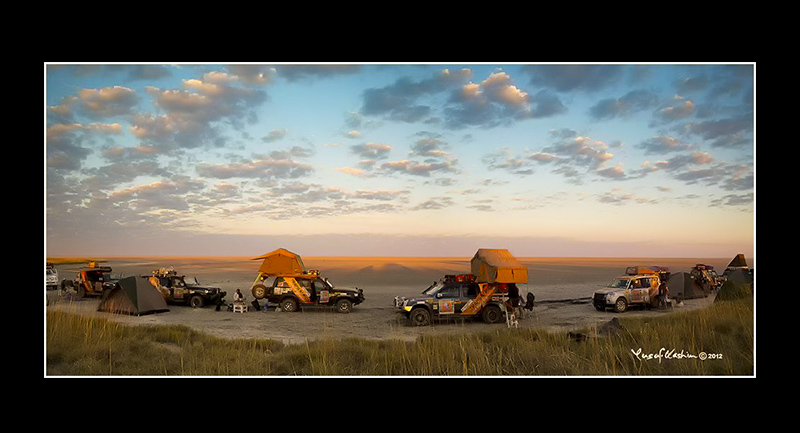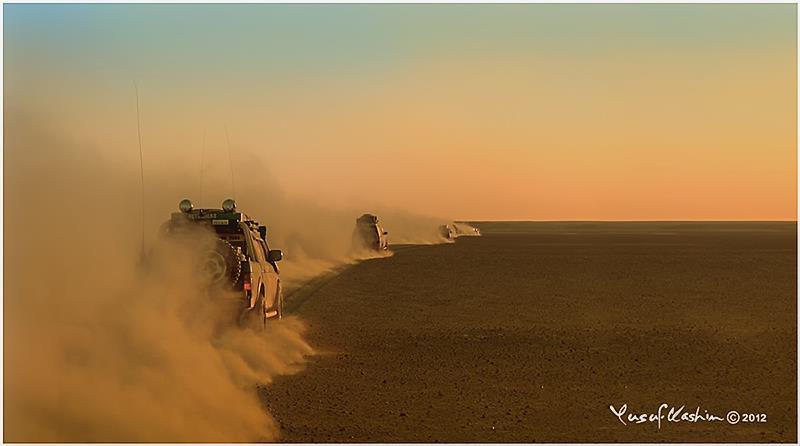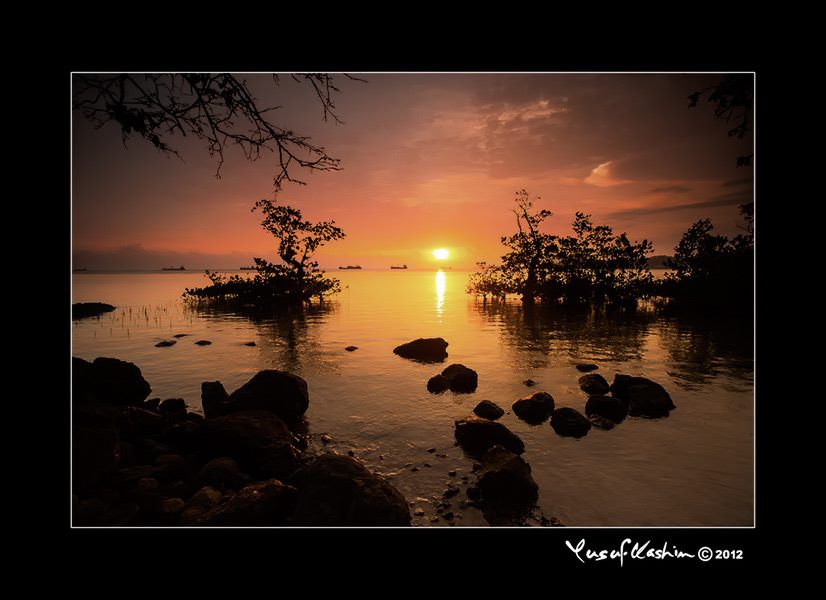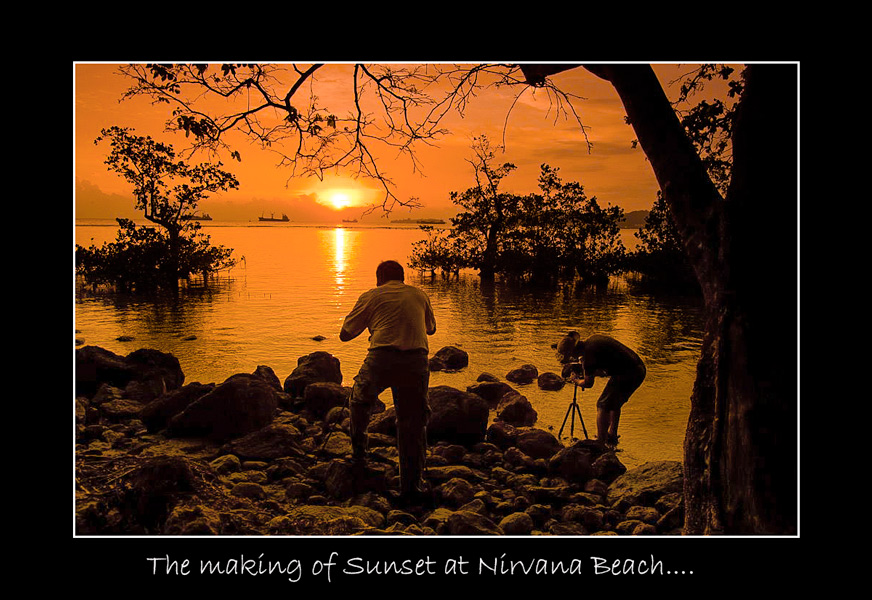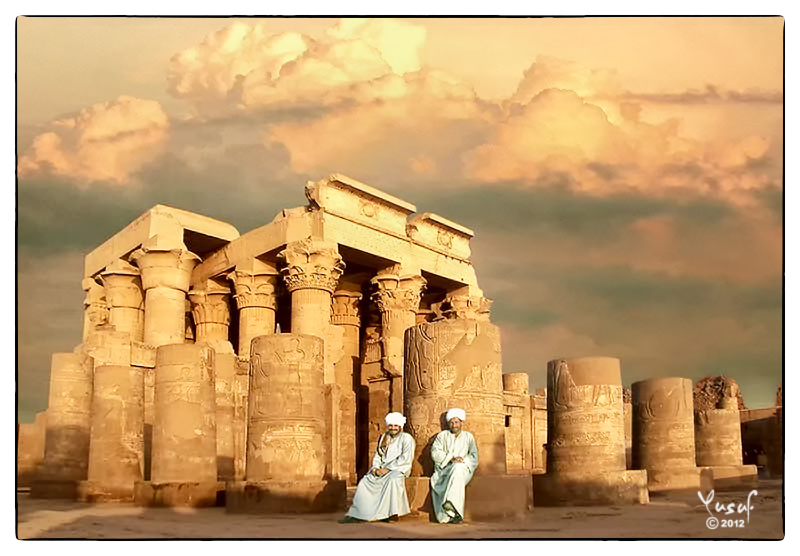Written by Yusuf Hashim
I see a lot of flat, uninteresting snapshots in PhotoMalaysia which their owners call a sunset, and with whatever little I know, I’ve often tried to make some constructive comments directed especially to newbies. The following are some thoughts which I hope newbies will find useful.
When shooting sunrises and sunsets, your aim should be to create a picture, not just a snapshot of the sky. You need to think and plan a little bit more than just a point and shoot approach, because the beauty of sunsets does not lie in the sun or the dramatic sky alone. If you only shoot the sky, its nothing more than a snapshot of the sky. There’s no creativity involved and any newbie with a P&S can do that. To rise above the ordinary, look around the scene and try to include a foreground, a middle ground and a background shape or silhouette which most times can look dramatic against a spectacular glowing backdrop.
The foreground silhouette can be a tree, a person, a boat, a plane, a statue, an animal, a bird, etc . An overhanging branch can help to frame the sun ,and can also fill up a wide expanse of uninteresting sky.
A silhouetted hedge or a row of deck chairs can break the monotony of a boring expanse of ocean. Besides adding an additional point of interest, a foreground silhouette also provides that all important illusion of depth. Remember, a photo is two dimensional and flat, and elements like distant hills, silhouettes in the foreground, and elements in the middle ground can help fool the brains of viewers. When the brain sees two or more overlapping layers like that, it registers the picture as three dimensional, and therefore closer to the real McCoy.
If you want to improve your photography and you think the location is interesting, come back again on another day and try to recompose the picture into something more considered than just a snapshot of clouds lighted by the setting sun. When you are at a location, walk around, and look around and work the scene by considering all possible perspectives. . Here are two shots of a sunset at Sekinchan, the Rice Bowl of Malaysia. The first is a shot looking West, facing the sunset :-

A photo of a sunset should not be only a colourful sky. Try to add elements in your frame to sell an interesting visual story as well.
After shooting this shot, I walked around to the other side, and shot the following photo facing East, where the sky is not as dramatic as when you are facing west. But it does give me an alternate perspective. When you are out shooting, don’t just stay rooted in one place. Walk around. Try to shoot alternative perspectives. If the location is good, shoot from several perspectives. Bracket shots. Shoot with various GND and other trick filters. Shoot 30% overlapping shots to try and see if panoramas would get you better perspectives. Work the scene and squeeze as much as you can from it. Remember, the only perspective may not be the best perspective.
The difference between a snapshot and a considered image lies in the deliberate way in which the considered image has been planned and thought about. A snapshot is simply that. You see a scene whose colours dazzles your eye, and usually without much thought, you snap the picture. That’s why its called a snapshot. It was snapped without much thinking.
And when others see the shot, they immediately notice the boring flatness, which you didn’t realize when you snapped-shot it. You thought the picture was great when you shot it, but you didn’t think why it was great then. It was great when you saw it because you had the benefit of being there. The breeze was in your face. The sun was warm on your skin. The colours you saw was nature’s work at its best, not some clumsy attempt at HDR. You could hear the birds singing, and feel the texture of the sand beneath your bare feet. In other words, you were seeing the scene with all five of your god given senses, not just your eyes.
But the viewer of what you thought was your fantastic sunset picture, sitting in front of his PC, doesn’t have the benefit of the other senses that you had when you were actually there shooting the picture, so he sees the image you made exactly as what your camera saw – a flat boring picture, very unlike the fantastic sunsets that no doubt he has himself also seen many times before. When we see something live, and in real time, it’s always our five senses working closely with our brains. In fact our brains have a fantastic filter system. It tells our eyes to skip the uninteresting bits and even if it is in our field of vision, like the proverbial lamp post growing out of the head of our subject, and the telephone wires coming out of their ears, our brain tells us to ignore it, so in real time, we actually see a brain filtered view. You have to consciously shut down your brain filters, and try to notice things in your frame that shouldn’t be there. If you do see something and you want to leave it out, the only way you can take it out is to MYA (Move Your Ass) so you can exclude it out of your frame.
Do remember that the camera captures everything. When we shoot pictures, we have to learn to override what our brain has filtered, but which our camera will still capture. We may have to change our viewpoint to exclude or to include certain elements. A photographer must be clever and sensitive enough to realise and see all this, and apart from excluding things which shouldn’t be in his frame, he must work hard to create an illusion of more than 2 dimensions in his picture.
At the highest level of making pictures, a photographer must know how to spike his image with an emotional charge. And if he succeeds, he will have succeeded in creating a sunset with soul. Then his image will truly be outstanding.
The above photo is a sunrise I shot at the Makgadigadik Pan in Botswana. The Makgadikgadi Pans National Park is one of Botswana’s lesser known tourist attractions. There’s not much to see there for the normal type of tourists, just as there’s not much to see for the disinterested or the unknowing, in the Salar de Uyuni of Bolivia and the Danakil Depression of Ethiopia. However, if you have an adventurer’s heart beating inside of you, the very mention of the Makgadikgadi Pans, the Okavango Delta and the Kalahari Desert of Botswana, will make your heart beat faster. Just to drive into the Massive salt pans alone is an adventure in itself. The powdery salt on the surface provides near zero traction, and just below the surface salt the material is like quicksand, making driving extremely difficult. But once you are inside, and camping out in the open where there is nothingness as far as the eye can see, the feeling is indescribable. The silence is deafening. Sunsets and sunrises are spectacular. And the feeling of isolation and being completely away from the rest of the world simply cannot be experienced elsewhere. Covering an area of more than 16,000 sq km, the Makgadikgadi Pan is not a single pan as its name suggests, but many pans interrupted by sandy desert in between. When the temperature drops at night, we’d build a campfire, boil water for coffee, and sit around trading stories while nibbling on potato crisps. When sleepy, we’d sometimes drag our camp beds in the open, lie back and count shooting stars to lull us to sleep. That’s how life should be lived and not wasted in front of a TV set. And that was my frame of mind that morning when I crawled out of my tent to shoot this sunrise, with my back to the sun. If you want to go to this place, its at at GPS location at 20° 43′ 0″ S, 24° 57′ 3″ E.

There is extensive Layering in this shot. The rock is the lead in point, with the boy, the boat, the trees and the horizon creating depth within the image
On the right is a sunset I shot at Nirvana Beach in West Java. We were on a PhotoSafari to Java and this location is one of the unique places we take participants of our photosafaris to show them some techniques of how sunsets could be shot. In this photo I was deliberately trying to create an illusion of Depth by a layering of elements within the frame. My camera was positioned low behind the rock in the foreground to create a larger than life presence for the rock. This was to be my lead in point for my visual story. Then there is the boy, the rocks, the boat, the trees, the ship in the distance, the horizon and finally the sun. The eyes of the viewer are forced to follow these layers deeper and deeper into the frame.
What I’m trying to impress is that, when you shoot sunsets and landscapes, or anything at all, you need to think about all these things. How do you recreate those multi-sensory feelings and experience you had when you shot the sunset, into a two dimensional medium, which is what a picture is. It’s difficult, but doable. These issues are an elementary but necessary step towards making compelling pictures, not only of sunsets, but also of everything else.
Try shooting the sun with lenses of different focal lengths if you have them. A different lens will give a different perspective. A long telephoto for example, will have only about an 8 degrees of view. Telephotos compress perspectives and suggests a paparazi, intrusive feel to a photo, while wide angles are inclusive and tends to pull a viewer into the photo, making him feel that he is a part of the photo. I like shooting landscapes with very wide lenses, and my favourite is a 16-35mm zoom lens.
You should explore alternative viewpoints using different focal lengths. Look for interesting elements to include into your picture. Be conscious of what to leave out. Take several shots at different exposures to learn the effect of varying the aperture and shutter speed. Remember that the magic moments of a sunset or sunrise, lasts only a few minutes, and you have to work quickly. It takes only 6 minutes for the sun to travel the distance of its diameter. As the magic moments often lasts only a few seconds, you have to arrive early to set you camera up on a tripod located at a carefully pre-chosen viewpoint. Set your camera into auto bracketing mode, but take it out of the auto white balance mode. And shoot in RAW because RAW will give you the widest latitude in post processing to recreate the magic that you saw. Noise, clipped highlights and blocked shadows, will be issues that are usually a problem in low key and high contrast shots which most sunset/sunrises are.
Learn also to type “Sunset” into Google, and hit “Search Images”, and you will be presented with thousands of sunset images which you can study in your own learning & discovery journey. Its really a humbling experience, which at worst, can teach you much about what are truly exquisite sunset pictures. But most people wont do that so they will continue to depend on luck and continue to shoot mediocre snapshots to punish their viewers. You’ve got to make a picture, not just shoot snapshots. That’s the difference between a good photographer and an indifferent one.
The two hours before sundown and the two hours after sunrise are known as the golden hours. With the sun being low in the sky, the horizontal light gives shape, body and texture to your subjects. Try not to think only of shooting the colourful sky created by the setting or rising sun. It was going into evening in Aswan after I crossed Lake Nasser between Sudan and Egypt. I saw how beautiful the light was, so I took a relaxing ride on a Felluca across the Nile, just to enjoy the breeze and to shoot some Nile-scapes. Here’s a sample of what I saw and shot from my Felluca, or Egyptian Sailing Boat…
Some of the most beautiful sunsets I’ve ever seen were in the deserts of the world. The dust in the desert air transforms the setting sun into a glorious red and orange ball of fire. The photo below was shot through the windscreen of a go anywhere Toyota Landcruiser, with one hand on the steering wheel, and the other steadying a camera. We were on an epic journey, driving for 45 days across the Sahara Desert of Libya, from Khartoum in Sudan, to Casablanca in Morocco. We drove through the Sahara Desert of Egypt, Libya, Algeria, Tunisia and Morocco, getting repeatedly stuck in the sands, and deep in the Sahara Desert of Libya, we were marooned for three days without fuel….. that was fun, but bloody hot …..
When we were on our PhotoSafari to Angkor Wat in Cambodia, we woke up at the unearthly hour of 4 am, just so that we could arrive in time to shoot the famed Angkor Wat ruins at sunrise. Alas, when we got there in pitch darkness, there were already a zillion people waiting to shoot the sunrise that morning. I scratched my head trying to think of something original and different to shoot from the zillions of pictures that must have been shot of Angkor Wat at sunrise from where I stood.
Aha, I remembered the Baoding Shiatsu exercise balls I’d bought the day before at the tourist market in Siem Reap. They were made of glass and were in my camera bag. I held up the Shiatsu Ball in my left hand, and shot this picture with my G10 Point and Shoot in my right hand. The Khmer man who sold me the Shiatsu balls spoke good English. He explained that if you twirl the Baoding balls in your palms, they will massage the meridians in it, much like Shiatsu massage or acupuncture. The meridians or Jingluo are channels through which your Qi or vital energy circulates. He said your 10 fingers are connected through the Jingluo to your vital organs, such as your brain, heart, liver, spleen, lungs, kidneys, gall bladder, stomach and intestines. Twirling the Shiatsu Balls in your palms will stimulate the Jingluo, resulting in better circulation of vital energy and blood within your body….much like foot massage. But this picture is another use for those Baoding balls. — shooting the sunrise at Angkor Wat, Siem Reap, Cambodia.
The picture above was shot on one beautiful morning on Dal Lake in Srinagar, Kashmir. This photo was inspired by Edward Steichen’s The Pond-Moonlight, shot in 1904, reputedly the world’s most expensive photograph in 2006 when it was sold at Sotheby for US$2.9 mil. Steichen’s photograph is supposedly beautiful, and bears the impressionistic quality of early photography. Steichen was exploring the limits of the photographic plate. I’m simply and crudely also experimenting limits of the digital media when shooting Sunrise and Sunsets..
Below is another Sunset at Nirvana Beach in West Java. This beach is a good location for illustrating the elements that would make a good sunset photo..
And here’s a photo showing yours truly shooting the Sunset at Nirvana Beach above. Uncle Fang is in the water upto his ankles shooting the same sunset with his Leica. Kind of reminded me of Uncle Khair who had a couple of Leica lenses in his trousers pocket and was also shooting a sunset at Marang in Trengganu. He was so engrossed in his shooting that he walked deeper into the water upto thigh depth before realizing that he had RM50K worth of Leica compact lenses in his pockets…
Sunset on the Road to Phnom Penh. We were driving to Phnom Penh from Siem Reap to catch a plane home when I noticed this sunset priming up. So I stopped the car, and shot the photo below hand held..
The sunset below show the ruins of the Temple of Kom Ombo near Luxor, on the banks of the Nile at Dusk. Built 2200 years ago, this temple was dedicated to Sebek, the Crocodile Headed God of Fertility and Creator of the World, and to Horus, the Falcon headed Sun god. Ombo in old Egyptian means ‘City of Gold’. In ancient Egypt, the city was a focal point for traders from Nubia (Sudan) where there were many gold mines. As the sun sinks below the horizon, Kom Ombo is first bathed in a beautiful hue of gold, then in violet, before darkness consumes everything. You have to be there to feel the magic – my picture doesn’t do the scene justice — at Kom Ombo Temple. But do you notice the two temple keepers in the photo? A human element in your sunset photo will always act as a focal point of interest, because a human form is where the eyes of every other human being will first go to, in a photo.
Below is another sunset photo shot in the Sahara, way back in 2004 when I was driving from Khartoum to Casablanca across the Sahara Desert of Egypt, Libya, Algeria, Tunisia and Morocco. This was shot one handed, with my ancient EOS 10D and a 24-70mm at f/2.8 and 1/2000 sec, ISO 200, through the windscreen of a Toyota Landcruiser, with my other hand on my steering wheel..
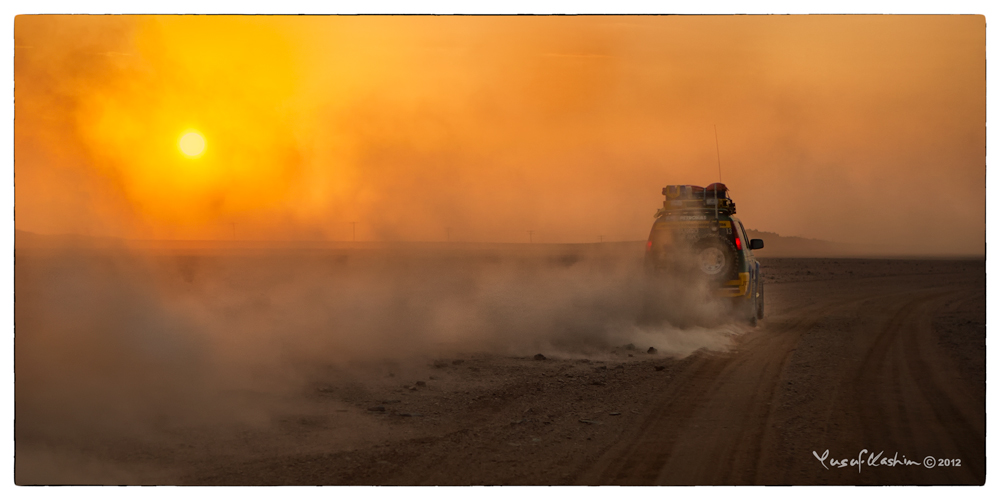
Sunset in the Sahara, shot through the windscreen of a Toyota Landcruiser, with one hand holding an old EOS 10D, and my other hand on my steering wheel
So there you have it. A rather longish rant about how I shoot sunsets and sunrises. The point I want to make is that sunsets and sunrises are not only about the sun and the colourful sky. Because horizontal light is great for bringing out textures, shapes and body of your subjects, try to shoot something more than just the sun and the colourful sky. Every newbie does that. Try to shoot a bit more of a visual story. I also should say that a set of GNDs or Graduated Neutral Density Filters will be very useful in managing the wide exposure latitude between the highlights of the sun and the shadows in the darker areas. You need to use a tripod because shutter speeds tend to be longer during twilight and dawn. And it is compounded by the fact that for landscapes a small aperture is necessary to ensure a deep DOF or Depth of Field. In fact a remote release for your shutter is almost essential as well to minimise the dreaded shakes. A last point is, dont use AWB or Auto White Balance, because the AWB setting will wash out all the beautiful saturated colours of Sunsets and Sunrises. And shoot in RAW to give the proverbial silver spoon to your photos at birth. No sunset or sunrise will look its best without a bit of post processing to enhance hues.
Yusuf Hashim



